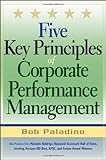Five Key Principles of Corporate Performance Management
- ISBN13: 9780470009918
- Condition: New
- Notes: BRAND NEW FROM PUBLISHER! 100% Satisfaction Guarantee. Tracking provided on most orders. Buy with Confidence! Millions of books sold!
In Five Key Principles of Corporate Performance Management, Bob Paladino shares his decades of experience to provide proven, real-world implementation insights from globally recognized and award-winning organizations. You’ll discover what today’s Fortune 100 companies are doing right, and how to implement their enterprise techniques and strategies within your own organization to maximize success.
List Price: $ 45.00
Price: $ 15.00
Check This:
 Six Sigma For Dummies
Six Sigma For DummiesThe world’s largest and most profitable companies – including the likes of GE, Bank of America, Honeywell, DuPont, Samsung, St…
 The Certified Six Sigma Green Belt Handbook
The Certified Six Sigma Green Belt HandbookThis reference manual is designed to help those interested in passing the ASQ’s certification exam for Six Sigma Green Belts, th…
 Certified Six Sigma Green Belt Exam Flashcard Study System: CSSGB Test Practice Questions & Review for the Six Sigma Green Belt Certification Exam
Certified Six Sigma Green Belt Exam Flashcard Study System: CSSGB Test Practice Questions & Review for the Six Sigma Green Belt Certification ExamCertified Six Sigma Green Belt Exam Flashcard Study System uses repetitive methods of study to teach you how to break apart and qu…



Real-World Experience TrumpsTheory Every Time,
So many of the business books available today are written by authors with little practical experience to back them up. It’s very easy to come up with a theoretical approach to improving business performance. The problem is, most theories don’t account for the realities of the business environment that only real-life, in-the-trenches experience teaches. Instead of selling an approach to performance management developed in an academic or theoretical environment, Bob Paladino has instead brought to this book real-world examples of how actual companies, by applying his five key principles, have achieved measurable and ongoing success. The book is straight-forward, and offers a broad-enough cross sampling of case studies that the reader is able to find commonality to which they can link their own efforts at performance management. Clearly not a one-size fits all approach, but rather practical advice from someone who’s been there before, and succeeded at achieving measurable and lasting results.
Was this review helpful to you?

|How CPM can achieve sustainable competitive advantage,
Many senior-level executives are about to launch or are now in the midst of performance improvement initiatives of one kind or another such as TQM, Lean, Six Sigma, or some variation thereof. For them especially, the material that Bob Paladino provides in this book will be of substantial value because he offers a remarkably comprehensive briefing on all manner of best practices from a variety of sources which include the U.S. President’s Malcolm Baldridge National Quality Award recipients, the Kaplan and Norton Global Balanced Scorecard Hall of Fame inductees, recipients of the Deming Quality Award, Fortune magazine’s “100 Best Companies to Work For,” Best Practice Partner Award recipients selected by APQC (previously known as the American Productivity Center and the American Productivity & Quality Center), and Forbes magazine’s “Best Managed Companies.” From this abundance of information, Paladino has identified “five key principles” that, in my opinion, are relevant to any organization (regardless of size or nature) that is committed to producing more and better results in less time, and at a lower cost. Hence the importance of effective corporate performance management (CPM).
He carefully organizes his material within nine chapters, devotes a separate chapter to each principle, and then in the final chapter provides a three-step “CPM Diagnostic” to conduct a self-assessment and baseline where each reader is at this point in her or his corporate performance management “journey.” (Paladino’s choice of the word “journey” is appropriate, given the fact that performance improvement initiatives are best viewed as a “marathon” rather than as a “sprint.”) I especially appreciate Paladino’s brilliant use of a lean best practice case study approach to strategy management to bring together disparate methods into an integrated, simplified CPM framework.
In fact, most case studies are segmented and extended within Chapters 3-9, coordinated with his focus on a separate best practice in each chapter. The commendably varied exemplar (i.e. high performance) organizations include Crown Castle International, the City of Coral Springs (FL), the Tennessee Valley Authority, LB Foster Company, the American Red Cross, Ricoh, and Sprint Nextel. Supplementary case studies include those of the Florida Department of Health (Chapter 6), Houston Chronicle (Chapter 7), and Raytheon Company (Chapter 8). Important lessons can be learned from these high-performance organizations, lessons that can help others to avoid becoming one of the nine of ten that fail to implement their business strategies.
Paladino cites the results of rigorous and extensive research conducted by Robert S. Kaplan and David P. Norton that reveals four common barriers: vision (only 5% of the workforce understands the strategy), management (only 15% of executive teams spend more than one hour per month discussing strategy), people (only 25% of managers have incentives linked to strategy), and resources (only 40% of organizations link budgets to strategy). To repeat, important lessons can be learned from these high-performance organizations, lessons that can help others to avoid becoming one of the nine of ten that fail to implement their business strategies.
Whether or not decision-makers who read this book learn these lessons and then take appropriate action in response to them is, of course, for them to decide. There’s “bad news” and “good news.” First the bad news: Most probably won’t. Now the good news: Most probably won’t.
Was this review helpful to you?

|